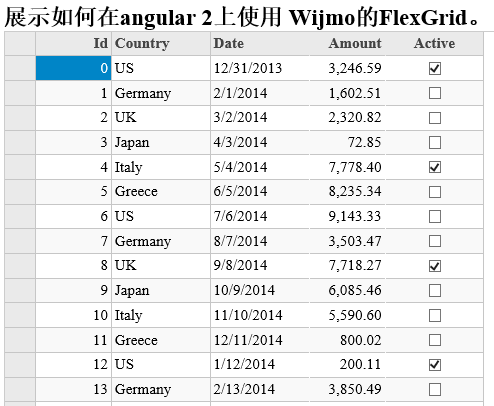这篇文章主要为大家展示了“支持Angular2表格控件的示例分析”,内容简而易懂,条理清晰,希望能够帮助大家解决疑惑,下面让小编带领大家一起研究并学习一下“支持Angular2表格控件的示例分析”这篇文章吧。
公司的一个项目想基于Angular 2的2.4 版本进行开发,目前还在进行前期的调研阶段。我担当的任务就是研究基于Angular 2的UI控件,在官方网站的资源中列出了很多支持Angular 2的资源。发现Wijmo的Flexgrid控件已经支持Angular 2的2.4版本,初步满足我们的需求。

一、环境搭建
Angular 2不仅是功能上和Angular 1有很多的差别,环境搭建也是区别很大。很多初学者反馈Angular 2的代码很难运行起来。Angular2是基于ES6来开发的,所以会有很多第三方依赖。由于很多浏览器还不支持ES6,所以Angular2引入了很多polyfill或者shim, 导致我们引入了第三方依赖。下面以FlexGrid为例来说明如何搭建运行环境。
1、 安装NodeJS
可以从Node官网下载 https://nodejs.org/en/download/。
2、 新建目录来存放项目
mkdir ng2-flexGrid
cd ng2-flexGrid
3、 配置文件
package.json
用来标记项目需要使用的npm依赖包。
{ "name": "wj-ng2-flexgrid", "version": "1.0.0", "scripts": { "start": "tsc && concurrently \"tsc -w\" \"lite-server\" ", "lite": "lite-server", "tsc": "tsc", "tsc:w": "tsc -w" }, "licenses": [ { "type": "MIT", "url": "https://github.com/angular/angular.io/blob/master/LICENSE" } ], "dependencies": { "@angular/common": "~2.1.1", "@angular/compiler": "~2.1.1", "@angular/core": "~2.1.1", "@angular/forms": "~2.1.1", "@angular/http": "~2.1.1", "@angular/platform-browser": "~2.1.1", "@angular/platform-browser-dynamic": "~2.1.1", "@angular/router": "~3.1.1", "@angular/upgrade": "~2.1.1", "angular-in-memory-web-api": "~0.1.13", "core-js": "^2.4.1", "reflect-metadata": "^0.1.8", "rxjs": "5.0.0-beta.12", "systemjs": "0.19.39", "zone.js": "^0.6.25" }, "devDependencies": { "@types/core-js": "^0.9.34", "@types/node": "^6.0.45", "concurrently": "^3.0.0", "lite-server": "^2.2.2", "typescript": "^2.0.3" } }tsconfig.json
TypeScript的配置文件,定义TypeScript 编译器如何从项目源文件生成 JavaScript 代码。
{ "compilerOptions": { "target": "es5", "module": "commonjs", "moduleResolution": "node", "sourceMap": true, "emitDecoratorMetadata": true, "experimentalDecorators": true, "removeComments": false, "noImplicitAny": false } }systemjs.config.js
为SystemJS(模块加载器)提供到哪里查找应用模块的信息,并注册了所有必备的依赖包。
/** * System configuration for Angular samples * Adjust as necessary for your application needs. */ (function (global) { System.config({ paths: { // paths serve as alias 'npm:': 'node_modules/' }, // map tells the System loader where to look for things map: { // our app is within the app folder app: 'app', // angular bundles '@angular/core': 'npm:@angular/core/bundles/core.umd.js', '@angular/common': 'npm:@angular/common/bundles/common.umd.js', '@angular/compiler': 'npm:@angular/compiler/bundles/compiler.umd.js', '@angular/platform-browser': 'npm:@angular/platform-browser/bundles/platform-browser.umd.js', '@angular/platform-browser-dynamic': 'npm:@angular/platform-browser-dynamic/bundles/platform-browser-dynamic.umd.js', '@angular/http': 'npm:@angular/http/bundles/http.umd.js', '@angular/router': 'npm:@angular/router/bundles/router.umd.js', '@angular/forms': 'npm:@angular/forms/bundles/forms.umd.js', '@angular/upgrade': 'npm:@angular/upgrade/bundles/upgrade.umd.js', // other libraries 'rxjs': 'npm:rxjs', 'angular-in-memory-web-api': 'npm:angular-in-memory-web-api/bundles/in-memory-web-api.umd.js' }, // packages tells the System loader how to load when no filename and/or no extension packages: { app: { main: './main.js', defaultExtension: 'js' }, rxjs: { defaultExtension: 'js' } } }); })(this);4、 运行npm install

NPM会根据package.json中定义的包进行安装。会产生一个node_modules目录,将这些包放在这里。
至此环境搭建的任务就已经完成了。下面我们以FlexGrid为例说明支持Angular 2。
二、支持Angular 2的表格控件如何使用
1、HTML
<html> <head> <meta charset="UTF-8"> <title>使用 Angular 2 来创建FlexGrid控件</title> <!--angular 2 模块--> <!--用于填充旧版浏览器--> <script src="node_modules/core-js/client/shim.min.js"></script> <script src="node_modules/zone.js/dist/zone.js"></script> <script src="node_modules/reflect-metadata/Reflect.js"></script> <script src="node_modules/systemjs/dist/system.src.js"></script> <!--systemjs 配置--> <script src="systemjs.config.js"></script> <!--wijmo 模块--> <script src="scripts/vendor/wijmo.min.js"></script> <script src="scripts/vendor/wijmo.grid.min.js"></script> <link rel="stylesheet" href="styles/wijmo.min.css"> <script src="scripts/vendor/wijmo.angular2.min.js"></script> <!--mine--> <script> System.import('./app/main').catch(function(err){ console.error(err); }); </script> </head> <body> <!--申明根组件--> <app-cmp> Loading </app-cmp> </body> </html>在HTML宿主页面中,除了Angular 2中必须的组件,还需要引入Wijmo脚本。
2、编写数据服务
'use strict' import { Injectable } from '@angular/core'; @Injectable() export class DataService { getData(count: number): wijmo.collections.ObservableArray { var countries = 'US,Germany,UK,Japan,Italy,Greece'.split(','), data = new wijmo.collections.ObservableArray(); for (var i = 0; i < count; i++) { data.push({ id: i, country: countries[i % countries.length], date: new Date(2014, i % 12, i % 28), amount: Math.random() * 10000, active: i % 4 == 0 }); } return data; } }3、编写根组件
现在我们编写应用的第一个组件:根组件 app.component ,也是这个程序唯一的组件。在这个组件中,需要引入两个元标记:Component, Inject。还需要注入定义的数据服务data.Service。
app.component.ts:
import { Component, Inject } from '@angular/core'; import { DataService } from '../services/data.service'; @Component ({ selector:'app-cmp', templateUrl:'app/components/app.component.html', }) export class AppComponent{ protected dataSvc:DataService; data: wijmo.collections.CollectionView; constructor(@Inject(DataService) dataSvc:DataService){ this.dataSvc = dataSvc; this.data = new wijmo.collections.CollectionView(this.dataSvc.getData(50)); } }app.component.html:
<div class="header"> <h3> 展示如何在angular 2上使用 Wijmo的FlexGrid。 </h3> </div> <div> <wj-flex-grid [itemsSource]="data"> </wj-flex-grid> </div>
在这里仅仅需要引入wj-flex-grid标记,就可以创建FlexGrid控件。wj-flex-grid 组件是作为一个子组件存在,在app.module 模块中注入。itemsSource 绑定一个数据源,这个itemsSource是flexgrid已经封装完成的属性。
在Angular 2下使用FlexGrid的最大好处就是:Angular 2组件提供了使用标记语言来声明控件的能力。声明标记很好地遵循了MVVM设计模式,我们可以完全通过View(标记语言)来配置我们的组件。FlexGrid支持使用Angular 2标记语言来声明完整的API。你完全可以使用标记语言设置属性,附加事件,配置子组件。
4、编写根模块
在根模块中将组件注入,需要将引用的所有的组件和模块都要注入进来。
import { NgModule } from '@angular/core'; import { BrowserModule } from '@angular/platform-browser'; import { WjGridModule } from 'wijmo/wijmo.angular2.grid'; import { AppComponent } from './components/app.component'; import { DataService } from './services/data.service'; @NgModule({ imports: [ WjGridModule, BrowserModule], declarations: [AppComponent], providers:[DataService], bootstrap: [AppComponent], }) export class AppModule { }5、引导程序
main.ts:
import { platformBrowserDynamic } from '@angular/platform-browser-dynamic'; import {enableProdMode} from '@angular/core'; import { AppModule } from './app.module'; enableProdMode(); platformBrowserDynamic().bootstrapModule(AppModule);三、运行
在命令行执行 npm start,这时,程序会自动打开默认浏览器并渲染页面。
start 命令是执行定义在 package.json 文件中的scripts命令。 会将ts代码编译为原生js,并且会启动一个静态服务器。 这个服务器会检测文件的变化,当发现文件改动,那么会自动编译ts代码。
下面是运行的结果:

FlexGrid内置的基本功能比如:排序、过滤、分组、编辑等,也以通过可选的扩展来提供其他功能。FlexGrid和其它产品比较,性能还是不错的。它的文件尺寸比较小压缩后约25K。
以上是“支持Angular2表格控件的示例分析”这篇文章的所有内容,感谢各位的阅读!相信大家都有了一定的了解,希望分享的内容对大家有所帮助,如果还想学习更多知识,欢迎关注亿速云行业资讯频道!
免责声明:本站发布的内容(图片、视频和文字)以原创、转载和分享为主,文章观点不代表本网站立场,如果涉及侵权请联系站长邮箱:is@yisu.com进行举报,并提供相关证据,一经查实,将立刻删除涉嫌侵权内容。